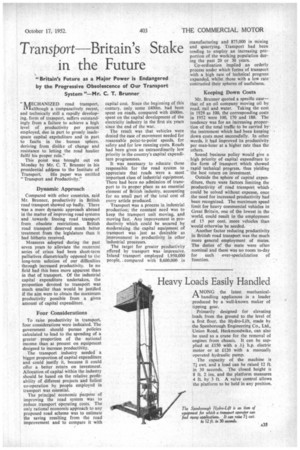Transport Britain's Stake in the Future
Page 53

If you've noticed an error in this article please click here to report it so we can fix it.
"Britain's Future as a Major Power is Endangered by the Progressive Obsolescence of Our Transport System "—Mr. C. T. Brunner
" NAECHANIZED road transport, Malthough a comparatively recent, and technically still a rapidly developing, form of transport, suffers outstandingly from a failure to achieve a high level of productivity per person employed, due in part to grossly inadequate capital expebditure and in part to faults in the human sphere, deriving from dislike of change and resistance to letting the road haulier fulfil his proper role."
This point was brought out on Monday by Mr. C. T. Brunner in his presidential address to the Institute of Transport. His paper was entitled "Transport and Productivity."
Dynamic Approach Compared with other countries, said Mr. Brunner, productivity in British road transport showed up badly. There was a more dynamic approach abroad in the matter of improving road systems and .towards freeing road transport from obsolete restrictions. British road transport deserved much better treatment from the legislature than it had hitherto received.
Measures adopted during the past seven years to alleviate the recurrent series of crises had been short-tem palliatives diametrically opposed to the long-term solution of our difficulties through increased productivity. In no field had this been more apparent than in that of transport. Of the industrial capital expenditure undertaken, the proportion devoted to transport was much smaller than would be justified if the aim were to obtain the maximum productivity possible from a given amount of capital expenditure.
Four Considerations
To raise productivity in transport, four considerations were indicated. The government should pursue policies calculated to lead to the spending of a greater proportion of the national income than at present on equipment designed to increase productiVity.
The transport industry needed a bigger proportion of capital expenditure and could justify it, because it could offer a better return on investment. Allocation of capital within the industry should be based on the relative profitability of different projects and fullest co-operation by people employed in transport was essential. The principal economic purpose of improving the road system was to reduce transport operating costs. The only rational economic approach to any proposed road scheme was to estimate the saving resulting from the road improvement and to compare it with capital cost. Since the beginning of this century, only some £400m. had been spent on roads, compared with £600m. spent on the capital development of the electricity industry in the first six years since the end of the war.
The result was that vehicles were denied the ease of movement needed for reasonable point-to-point speeds, for safety and for low running costs. Roads had been given an extraordinarily low priority in the country's capital expenditure programmes.
It was necessary to educate those responsible for the road system to appreciate that roads were a most important class of industrial equipment. There had been no admission of transport to its proper place as an essential element of British industry, accounting for no small part of the total cost of every article produced.
Transport was a process in industrial production; the constant need was to keep the transport unit moving, and moving fast. Any improvement in productivity which could be secured by modernizing the capital equipment of transport was just as desirable as improvement in productivity in other industrial processes.
The target for greater productivity offered by transport was impressive. Inland transport employed 1.950,000 people, .compared with 8,600.000 in manufacturing and 875,000 in mining and quhrrying. Transport had been tending to employ an increasing proportion of the working population during the past 20 or 30 years.
Co-ordination implied an orderly process under which forms of transport with a high rate of technical progress expanded, whilst those with a low rate contracted their spheres of usefulness.
Keeping Down Costs
Mr. Brunner quoted a specific case— that of an oil company moving oil by. road, rail and water. Taking the cost in 1929 as 100, the corresponding costs in 1952 were 100, 170 and 180. The tendency was for an increasing proportion of the total traffic to be carried by the instrument which had been keeping down costs most successfully. In other words, it had improved its productivity per man-hour at a higher rate than the others.
Sound business policy would give a high priority of capital expenditure to the form of transport which showed rapid technical progress, thus yielding the best return on investment.
Outside the sphere of capital expenditure, there were factors limiting the productivity of road transport which could be solved without expense, once the need for increased productivity had been recognized. The maximum speed limit for heavy commercial vehicles in Great Britain, one of the lowest in the world, could result in the employment of 15 per cent, more vehicles than would otherwise be needed.
Another factor reducing productivity in British road transport was the much more general employment of mates. The duties of the mate were often nominal and there was no room to-day for such over-specialization of function.




















































































